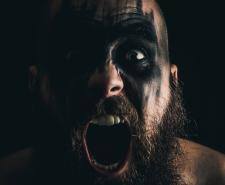
Read more about Vikings

One of the towering figures of the Viking age, Ragnar Lodbrok is known for his magical and militaristic exploits. These include slaying a giant serpent while wearing protective trousers (hence the moniker ‘Lodbrok’, meaning ‘hairy breeches’), and carrying out daring raids on the British Isles.
He also happened to be king of both Sweden and Denmark, and a prolific husband whose wives included the great beauty Aslaug and the shield-maiden Lagertha. Plus, he met his death in a way guaranteed to seal his enduring legend - thrown into a snake pit by a medieval English king.
All in all, rather impressive. But Ragnar’s sons were also no slouches when it came to Viking derring-do. Here’s what the Old Norse saga Tale of Ragnar’s Sons tells us of these remarkable 9th-century figures.
Björn Ironside
Björn Ironside was, like his brothers, a chip off the old block. Keen to demonstrate that they were as brave and war-like as their father, he and his siblings went off to conquer Nordic territories like Zealand, Jutland and Gotland. However, they proved their point a little too well.
Concerned about being overshadowed by his enthusiastic offspring, Ragnar appointed a vassal named Eysteinn Beli as king of Sweden, ordering him to safeguard the land against his sons. As a result, Beli’s forces ended up defeating and slaying two of Björn’s half-siblings.
News of this reached Björn and the lads while they were playing board games back in Zealand, and they wasted no time in mustering an ‘overwhelming army’ to take brutal revenge. On hearing that Eysteinn Beli had been defeated and killed, Ragnar’s immediate reaction was to outdo his sons’ victory by mounting an invasion of England with only two ships.
Unsurprisingly, Ragnar’s attempted conquest was unsuccessful and he was thrown into a snake-pit by Northumbria’s King Ælla for his trouble. Once again, Björn and his brothers were on the warpath for bloody revenge; they decisively defeated Ælla’s forces, resulting in the king’s back being cut open and his lungs pulled out – a ritual execution method known as the blood eagle.
Following this famous victory, the brothers carried on their conquering exploits, with Björn taking control of large swathes of Sweden. According to Icelandic lore, he established the Swedish dynasty known as the House of Munsö.
Ivar the Boneless
One of Björn’s colourfully-named brothers, Ivar the Boneless’s moniker continues to provoke debate. The ‘boneless’
might refer to brittle bone disease, a skeletal malformation, impotence, or simply a mistranslation of some other word. In any case, he’s one of the star players in the Tale of Ragnar’s Sons, conquering lands alongside his siblings, and playing a decisive role in the grisly revenge wreaked against King Ælla of Northumbria.
Ivar paved the way for the eventual invasion of England by negotiating a truce with Ælla. Saying that he simply wanted compensation for his father’s death, Ivar requested only as much land as he could cover with the hide of an ox. Ælla granted him his wish, and – according to Old Norse legend – Ivar cut the ox hide into strands so thin that they covered a vast stretch of land (said to be York).
Having established a base in England, Ivar invited his brothers to commence their attack on Ælla, who still rather naively believed Ivar wanted nothing but peace and reconciliation between Vikings and Northumbrians. Ivar personally oversaw the execution of Ælla and later became king of much of northeastern England. According to the saga, he ‘wasn’t short of cunning and cruelty’, and his long reign was undistracted by ‘lust or love’.
Sigurd Snake-in-the-Eye
Boasting an even more memorable handle than Ivar the Boneless, Sigurd Snake-in-the-Eye was so-called because he was born with a ‘mark in his eye, as if a snake lay around the pupil’.
Having accompanied his brothers on their early conquests in the Nordic regions, Sigurd’s fearless and battle-hungry nature was shown when he heard that his two half-brothers had been killed by Swedish leader, Eysteinn Beli. He swore that Eysteinn's rule would be ‘soon over, even if he offers payments big and brazen’.
Following the destruction of Beli, Sigurd also took part in the battle against King Ælla. In a curious twist, he ended up marrying Ælla’s daughter, Blaeja, who was perhaps coerced into tying the knot with one of the Viking warriors who’d killed her dad. Or perhaps it was a carefully considered strategic alliance. Whatever the reason, the saga tells us they went on to produce Cnut I, king of Denmark.
Hvitserk
Another hero of the Tale of Ragnar’s Sons, Hvitserk also boasts the best quotations in the whole saga. During the famous moment where the siblings are notified of their half-brothers’ deaths at the hands of Eysteinn Beli, Hvitserk is the most downright furious sounding of the bunch.
He tells Björn, Ivar and Sigurd that he’s itching to plan ‘how vengeance might be managed’ and how ‘various vile torments’ might be devised for Beli. He’s also keen to get on with it, imploring his brothers to get their boats onto the sea and ‘hew ice aside, slice it’ so they can start slaughtering Beli and his men as quickly as possible.
Later, after the killing of Ælla, Hvitserk is involved in further conquests and reigns over Jutland and Wendland (in today’s Germany). He is last spoken of in the saga as one of the Vikings who raided widely in France. Ragnar would have been proud.